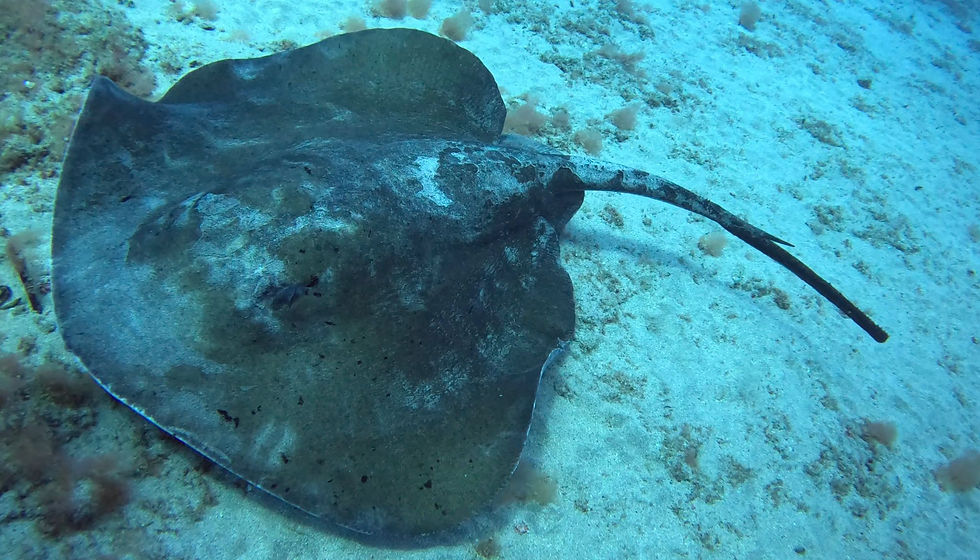Chatting about Seagrass Meadows
- Emmett Clarkin
- Jun 23, 2023
- 4 min read
Updated: Jun 25, 2023

Let’s have a brief look at this amazing environment and its importance here in the Canary Islands with our friend Dr Emmett Clarkin. Emmett is a Dr of Marine Biology and works with National Geographic expedition ships as a diver/scientist/photographer.
This is part of a planned collection of articles with Emmett, we hope you
enjoy them and come back soon to see more.
Seagrass Meadows
The shallow seas of Europe are home to one of the most incredible and important groups of species on the planet, the seagrasses. The only true plant to live in the ocean, they are also the only flowering plant species in the ocean, making them completely unique and special.
How many of us love to spend time by the sea, whether enjoying water sports or simply relaxing, not even knowing the majesty of what just lies beneath the surface? In many cases, only meters away from the shoreline, amazing meadows of seagrass can be found that are full of life and beauty.

Acting as an important nursery habitats for juvenile fish, shellfish and crustaceans…sea turtles”.
Seagrasses generally live in very shallow waters in tropical and temperate environments and are found from the sea surface at low tide to a depth of around 40 meters, as they depend on high levels of light for photosynthesis to grow. Anchoring their roots in mud, sand, or fine gravel, seagrasses can spread across the seafloor to what can only be described as an underwater meadow. Known as biogenic habitats, they create unique environments for many other organisms to live and thrive, acting as important nursery habitats for juvenile fish, shellfish, and crustaceans, and providing habitat for vulnerable species such as sea turtles and seahorses.
Not only do seagrasses create an environment that allows many other ocean species to survive and thrive, they also hugely benefit us humans and the planet, which is something that we humans like to call Ecosystem Services.
Seagrass meadows stabilize the seabed and prevent erosion with their roots, which, in turn, stabilizes and protects our coastlines from erosion by wind and waves. The seagrasses themselves dissipate the strength of waves and currents, allowing for calmer sea conditions nearshore and allowing essential nutrients from the ocean to settle out, enriching the environment and attracting other marine life.
Seagrass meadows are also invaluable in the fight against climate change for their carbon capture ability. They are one of the most efficient carbon storage environments on our planet. Known as 'Blue Carbon', they sequester and lock up huge amounts of carbon that has been dissolved into the ocean, and they do all this to support the growth of their roots and leaves. After the seagrass plant dies back, the dead material will collect on the seabed and if left undisturbed, can be stored with all its carbon locked up for thousands of years. Globally, seagrasses capture carbon from the environment 35 times faster than tropical rainforests.
“Seagrass meadows are in sharp decline”.
Alarmingly, in Europe and around the planet, seagrass meadows are in sharp decline, which has been attributed to climate change, coastal development, overfishing, and pollution. Pollution is the largest threat to the health of seagrass meadows globally, with high levels of nutrients from human activities running from the land into our coastal seas, often causing excessive algal growth that blocks the light that the seagrasses need to photosynthesize and grow.
The Canarian Archipelago has three known species of seagrass: Cymodocea nodosa, Halophila decipiens, and Zostera noltii, mostly located in the Eastern and Southern coasts of the islands in sheltered areas that are protected against the Trade Winds that dominate the Canarian coastal climate. Unfortunately, the Canary Islands have not escaped the decline of seagrass meadows either, with the well-known species Zostera noltii all but disappeared from the islands, except for a few small patches known in a single area of Lanzarote, with historical records in Fuerteventura and Gran Canaria. Again, human activities such as urban pollution, sedimentation, and physical disturbance have been attributed to this loss.
“Maybe we need to think about actively restoring some of our lost seagrass meadows“.
Seagrass meadows do so much to protect and nurture our marine species while at the same time providing us humans with invaluable ecosystem services. So, let's do everything that we can to protect these precious marine habitats for the health of our oceans and planet as well as for ourselves. Simple things like not littering, dumping hazardous wastes down our urban drains, or limiting the use of fertilizers and pesticides in agriculture can make a huge difference to our coastal water quality. If you drive boats at sea, avoid driving in shallow areas, keep your speed down to avoid boat wake disturbing the seagrass, and don't drop or drag your anchor within a seagrass meadow. Also, maybe we need to think about actively restoring some of our lost seagrass meadows, with transplanting or reseeding depleted areas once home to these incredible habitats.
I can't recommend enough going for a dive or snorkel within a seagrass meadow to experience this magical environment firsthand, and to meet some of its intriguing residents. If we love, respect, and promote our seagrass meadows, they will thrive and continue to nurture healthy coastal seas into the future, both for us to enjoy and for the wildlife that relies on them for survival.
----------
Dr Emmett Clarkin, Undersea Specialist / Expedition Diver









Comments